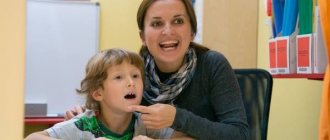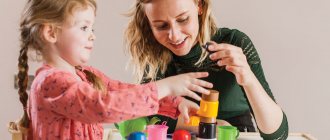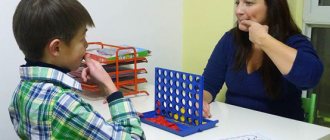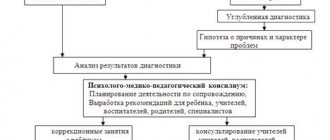Main directions of correctional work
Correctional and educational work with children with different levels of speech development is carried out in special groups for children with general speech underdevelopment. According to the “Model Regulations on Preschool Institutions for Children with Speech Impairments,” these groups include:
a) children with the first level of speech development starting from the age of 3 with a period of study of 3 - 4 years;
b) children with level II of speech development starting from the age of 4 with a period of study of 3 years;
c) children with the III level of speech development starting from 4-5 years of age with a training period of 2 years.
Classes are conducted with subgroups and individually.
The tasks and content of speech therapy work arise from the analysis of the structure of speech disorders, as well as the intact and compensatory capabilities of children.
The formation of oral speech in children is based on learning to compose sentences of different types.
The sequence of assimilation of sentence structures and grammatical forms is determined by how speech develops normally. The educational material and methodological techniques for each stage of work provide for gradual complication, but with mandatory reliance on what the child has already developed spontaneously or as a result of previous speech therapy work.
Taking into account the age and characterological characteristics of speechless children, pronounced speech negativism, reduced emotional activity, it is necessary from the very first lessons to create in the child a good mood, a desire to “play” (study) with a speech therapist, to actively contact him. The success of the first steps is largely determined by the extent to which the speech therapist can interest the child, organize a situation that is exciting for him, and create an incentive for him to follow. When working with children with level I speech development, the main tasks are the following:
1. Development of speech understanding.
2. Development of active imitative activity in the form of pronunciation of any sound combinations.
3. Development of attention and memory.
From the very first lessons, variants of various exercises are used, aimed primarily at developing the child’s active attention, the ability to listen attentively to speech addressed to him, and perform tasks based on verbal structures. At the same time, the meanings of a number of words are clarified - names of objects, actions, signs. It is important that the subject vocabulary is specific, and the actions are visual and easy to demonstrate.
Appeals to children should be in the form of incentive and interrogative sentences, which should contain the same words in different grammatical forms. Such exercises are carried out in a playful way with extensive use of visual situations, while an action response is allowed. For example: “Dunno came to visit us. He is looking for his friends. Who will help him find the dog Druzhka, the fox Alice, Puss in Boots? Show who has the dog Druzhok, where is the fox Alice. Who found Puss in Boots? Etc.
Correctional and speech therapy work on the formation of phrasal speech in children with general speech underdevelopment
One of the main goals of this work is to determine the directions and methods of work on the formation of phrasal speech in preschoolers with ODD.
We studied programs, methodological developments and recommendations of various authors in this direction (L.N. Efimenkova, N.S. Zhukova, E.M. Mastyukova, T.B. Filicheva, R.I. Lalaeva, N.V. Serebryakova, V.P. Glukhov, Kuzmina, Rozhdestvenskaya, etc.).
Having systematized this material, we determined the directions and methods of working with children on the formation of phrasal speech. In our correctional and speech therapy work, we rely on general didactic and specific principles. General didactic principles: scientific nature, accessibility, systematicity and consistency, strength.
Specific principles:
- Systematicity and consistency
- Development principle
- Ontogenetic principle
- Activity principle
- Accessibility principle
- The principle of individual approach
Stages of correctional and speech therapy work on the formation of phrasal speech in preschoolers with ODD,
stage I
Two-part simple sentences and with direct object in v.p.:
a) subject + predicate using pronouns (I am walking. He is sitting.);
Sample games and game exercises:
"Who's doing what?"
The speech therapist invites two children to sit on chairs and conducts a dialogue, asking questions:
- What are you doing, Vova? (I am sitting)
- What is Vitya doing? (He's sitting)
The verbs standing, standing, lying, lying, walking, going are processed in the same way.
Working with the model.
It is explained to the child that a sentence is “when words are friends.” The speech therapist invites the child to make a sentence (to make friends with words). Instead of the star on the left in the model, select and substitute a picture, and instead of the long strip, come up with an action word.
b) Predicate + object – direct object (Give me a cube. Can I have a toy?).
As a direct object, words are first used whose accusative case form coincides with the nominative case form.
"Choose a toy"
Children stand in a circle. In the middle of the circle there is a table on which toys are laid out (ball, cubes, shovel, doll). One of the children, throwing a ball to another, asks: “Vova, give me a ball (cube)”, “Tanya, give me a doll (spatula)”, etc.
The child who caught the ball must fulfill this request: put the ball on the table, take the named toy from the table, say: “Olya, take (take) the ball.”
c) subject + predicate + object: subject + predicate + direct object (The girl draws a house).
“Who eats what?”
The speech therapist shows the children pictures (see Appendix 4) with images of domestic animals and what they eat and says that with their help we will make sentences. Presents the child with two pictures (for example, a cow and grass), and the child independently composes a sentence: The cow is chewing grass. The horse is chewing grass. The dog chews on a bone. The cat laps milk.
Working with the model.
The speech therapist posts subject pictures (for example, with a picture of a girl, soup, bread and an apple). Invites the child to look at them and name them. And then introduces a new graphical model of a sentence:
Instead of the first star on the left in the graphic model of the sentence, the child is asked to put a picture about which you can ask: “Who is this?” (girl), and instead of the second star from the left - any of the remaining pictures. And then answer the speech therapist’s question: “What does the girl eat?” The child answers the question and pronounces the entire sentence (“The girl is eating soup”). The speech therapist asks you to count the number of words in the composed sentence, based on the model. Determine which word is first, which is second, which is third.
Next, we work with the deformed sentence. The speech therapist invites the child to listen to the sentence, find and correct the mistake made: “The girl eats the bread. (The girl eats bread.)"
Stage II
Common sentences of three or four words:
a) Subject + predicate + object + object: subject + predicate + direct object + indirect object
(The girl draws a house with a pencil).
Sample games and game exercises.
Working with the model.
The speech therapist lays out object pictures in front of the child (for example, pictures of dad, a bag, apples, potatoes, onions) and a graphic model:
The child names object pictures and substitutes a picture on the card instead of the first star on the left, about which you can ask: “Who is this?” (dad), and instead of the second asterisk from the left - a picture of “bag”. After this, the speech therapist invites the child to choose any of the remaining pictures (potatoes, apples and onions) and substitute it on the card instead of the third star. And then he asks you to make a sentence based on the card, with all the selected pictures and with the action word “bought.” For example: “Dad bought a bag of potatoes.” An analysis of the compiled proposal is carried out. The number and order of words are determined.
b) Subject + predicate + locative: subject + predicate + adverbial place (Children playing in the garden).
Sample games and game exercises:
“Think and answer!”
The child is asked to answer the questions:
- Where can you hang your coat? – The coat can be hung on a hanger.
- Where can I put my books? -...
- Where do shoes go? -...
- Who can you see at the zoo? -...
- Working with the model.
The child is presented with object pictures, a card with a graphic image of a specific preposition (at the discretion of the speech therapist) and a sentence model:
Sentences with each of the prepositions are sequentially compiled and analyzed. Instead of asterisks, pictures of objects are substituted into the sentence model. Instead of a short line - a small card with a graphic image of a preposition. Proposals are drawn up and analyzed. For example: “The ball is on the carpet.” “The girl sat down on the chair.” "The candy fell on the carpet." And so on.
In addition, the following types of activities using graphic diagrams are recommended:
Selection of proposals for this graphic model.
Independently come up with proposals based on this graphic model.
Drawing up a generalized representation of the meanings of sentences corresponding to one graphical model.
c) subject + predicate + object + locative: subject + predicate + object + adverbial place (The girl picks flowers in the garden).
Offer model:
The methodology for working with the model, games and game exercises are similar to the previous substage of work.
d) subject + predicate + object + attribute: subject + predicate + definition + complement (Grandmother gave a beautiful doll).
Offer model:
The methodology for working with the model is similar to the previous substage of work.
Sample games and game exercises:
"The offer fell apart"
Make sentences using these words. Words, including those in the “neutral form”, are offered first in the correct and then in a changed sequence):
Bear, honey, sweet, loves;
under, feet, creaks, snow, white;
snowflakes, light, spinning, etc.
e) Sentences with “double predication” (Grandfather is sitting in a chair and reading a newspaper.).
The methodology for working with the model, games and game exercises are similar to the previous substages of work.
Stage III
Complex sentences.
a) Complex constructions of two symmetrical parts, where the second part duplicates the first (The hare loves carrots, and the squirrel loves nuts.).
Sample games and game exercises:
Drawing up proposals for actions.
The speech therapist gives the task to two children:
- Lena, sit, Kolya, stop.
Children must make a sentence. For example: Lena is sitting, and Kolya is standing. And so on.
"Vegetables"
The speech therapist displays pictures of vegetables one by one. Children answer the question: where does this vegetable grow?
Sample answer: A cucumber grows on the ground. Turnips grow in the ground.
Next, children are asked to make a sentence based on two object pictures (For example, a tomato and a turnip).
Sample answer: Tomatoes grow in the ground and turnips grow in the ground.
b) compound sentences with a conjunction and
c) complex sentences with the conjunction so that
The methodology for working with the model, games and game exercises are similar to the previous substages of work.
Sample games and exercises to strengthen the skill of composing different types of sentences:
"Correct mistakes"
Goal: work on understanding common sentences.
Progress: Speech therapist: Dunno came up with sentences based on the pictures and mixed everything up. Help Dunno correct his mistakes. The goat brought food to the girl. The cup broke Lena. The ball plays with Sasha. The road goes by car. Vova broke the ball with the glass. Olya draws her dad with a picture. Mom carries a bag in cabbage.
"Finish the sentence"
Goal: to consolidate the structure of a complex sentence with the conjunction “so that”.
Progress: Speech therapist: I put on a warm fur coat so that... (... it would be warm. ... go for a walk. ... not freeze.) We turned on the light so that... (... it would be light. ... write letters. ... read a book.) We watered the flowers so that ... (... they did not wither. ... they grew quickly.) As a result of such step-by-step work, children with ODD begin to consciously use various types of grammatically correct sentences in active speech. That is, they master the basics of coherent speech.
Bibliography:
- Vorobyova V.K. Methods for the development of coherent speech in children with systemic speech underdevelopment: textbook. manual – M.: AST: Astrel: Transitkniga, 2006. – 158 p.
- Vorobyova V.K. Teaching children with severe speech impairments the initial skill of descriptive-narrative speech // Defectology - 1990. - No. 4. - P. 40-46.
- Glukhov V.P. From the experience of speech therapy work on the formation of coherent speech of children with special needs of preschool age in classes on teaching storytelling // Defectology - 1994. - No. 4.
- Glukhov V.P. On the formation of coherent descriptive speech in older preschoolers with general speech underdevelopment // Defectology - 1990. - No. 6.
- Kovshikov V.A. Expressive alalia. – M.: “Institute of General Humanitarian Research”, V. Sekachev, 2001.
- Filicheva T.B., Chirkina G.V. Elimination of general speech underdevelopment in preschool children: A practical guide. – M.: Iris-press, 2004. – 224 p.
- Chaladze E.A. Corrective work on the formation of text formation skills in preschool children with expressive alalia // Speech therapist in kindergarten - 2004. - No. 3. - P. 55-65.






